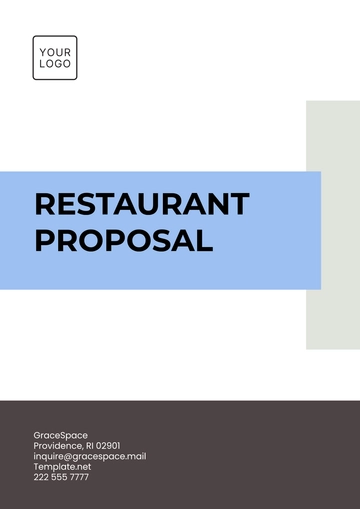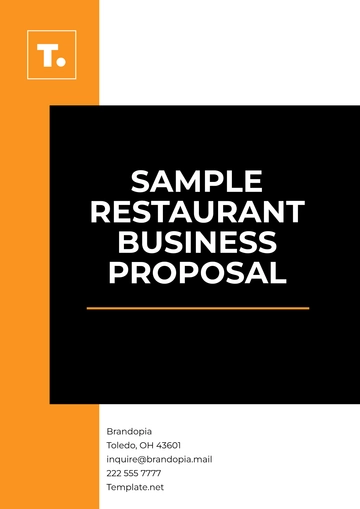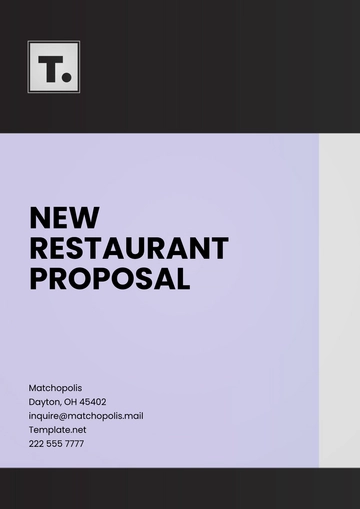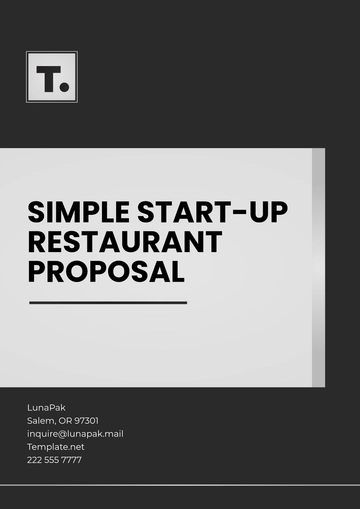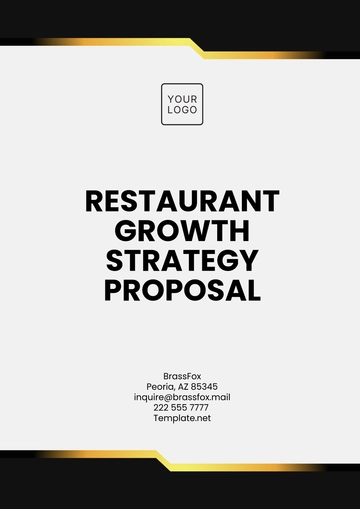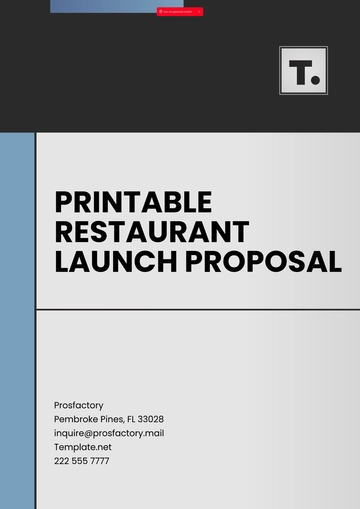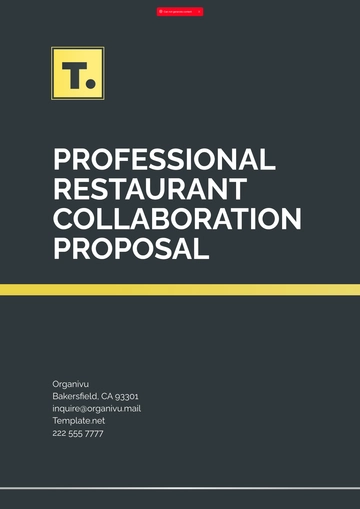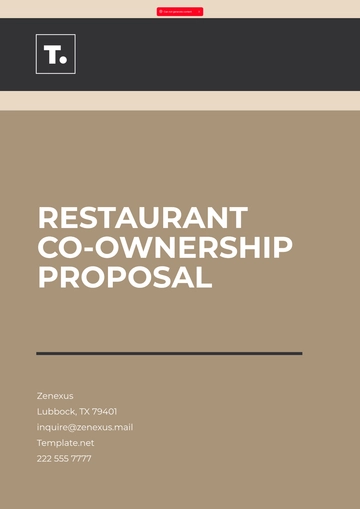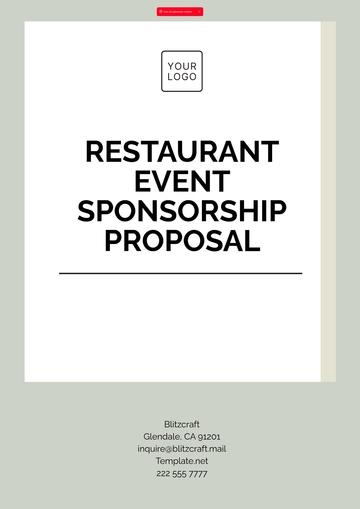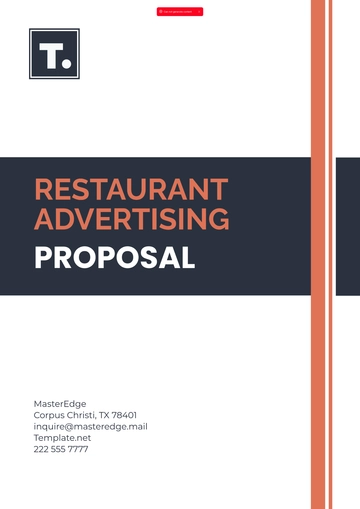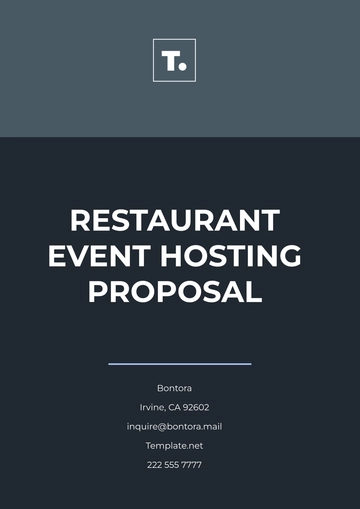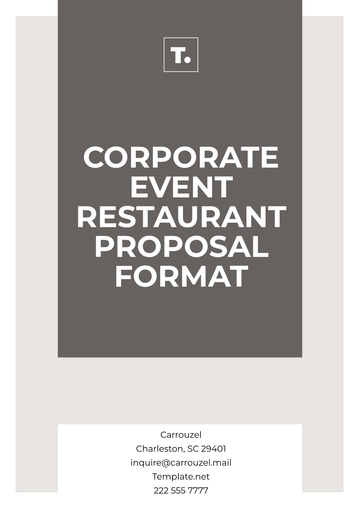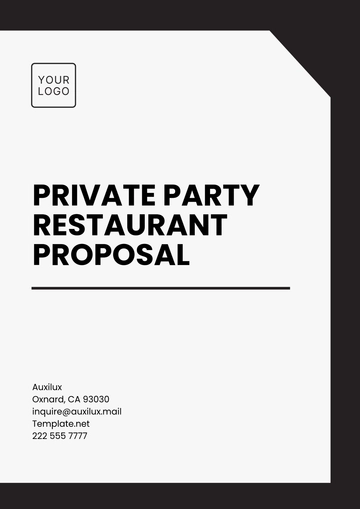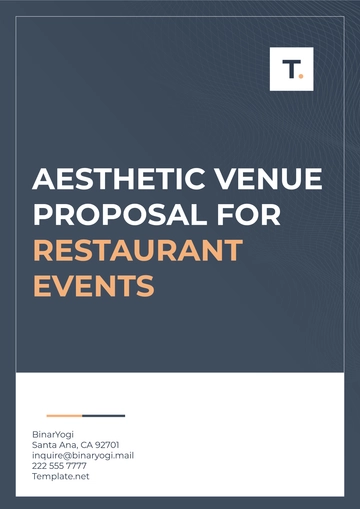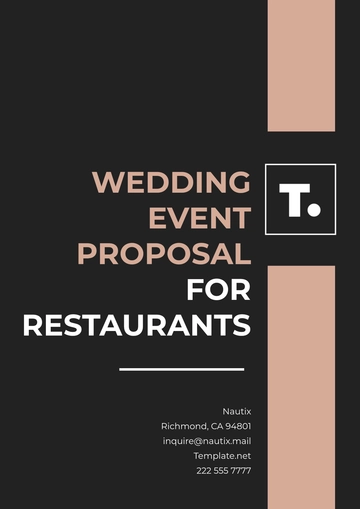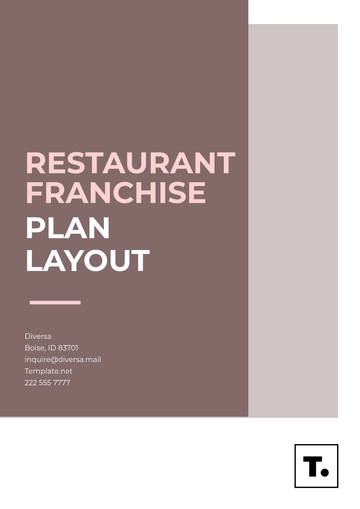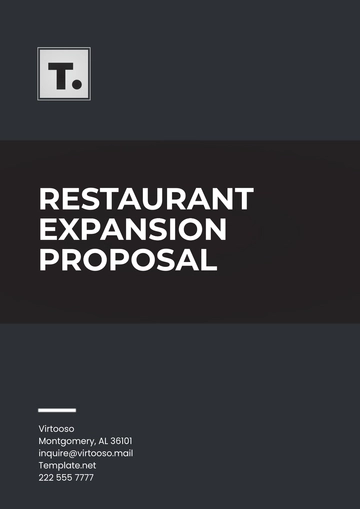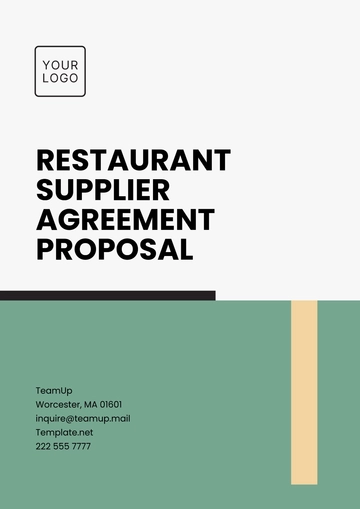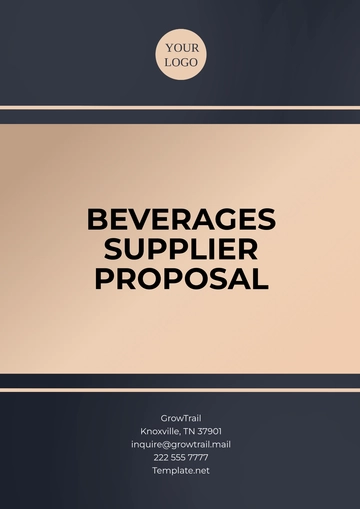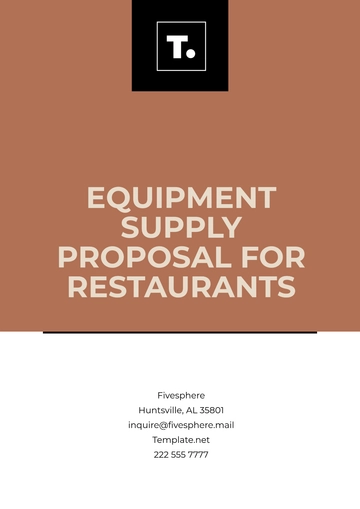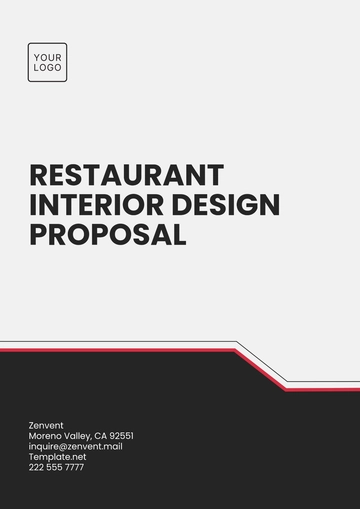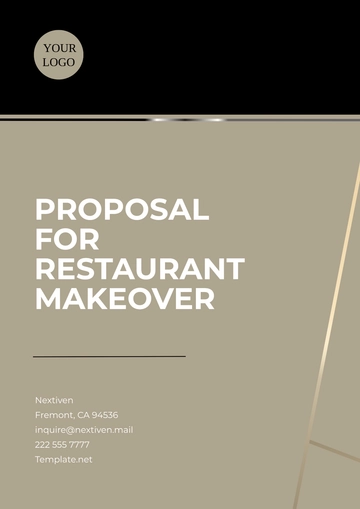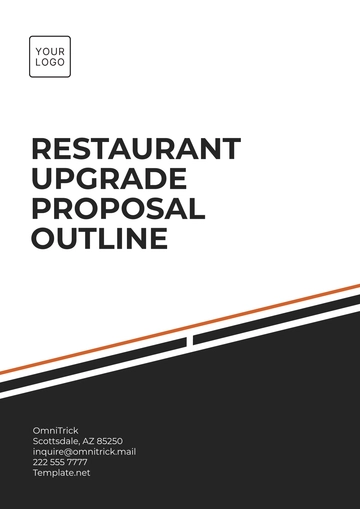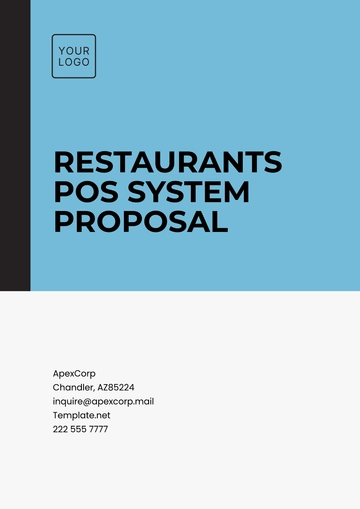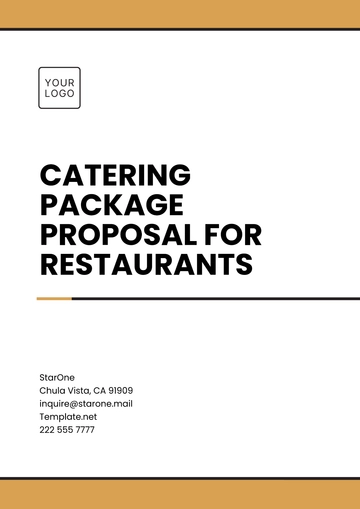Free Restaurant Project Proposal
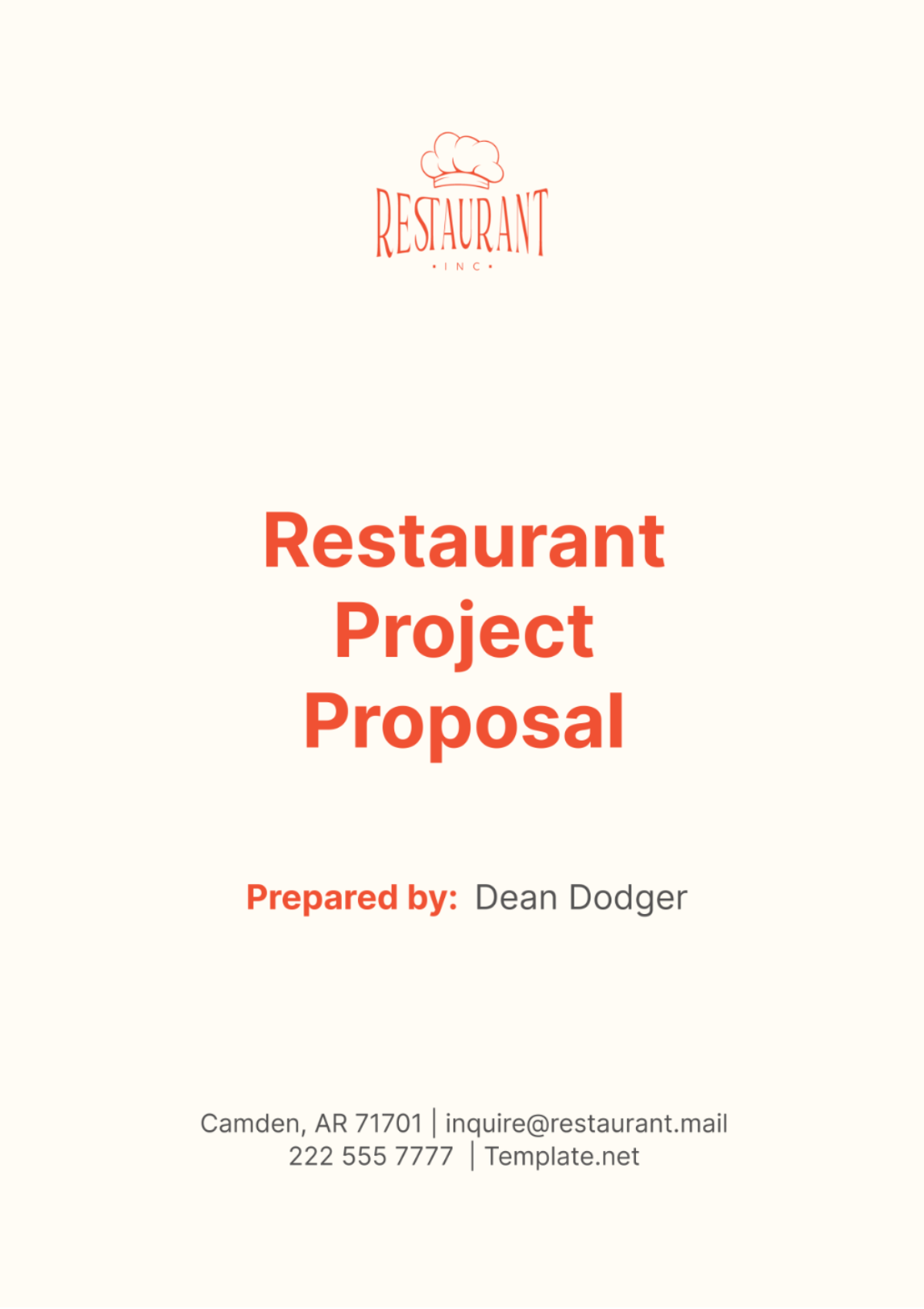
I. Executive Summary
A. Overview
Our proposed restaurant, [Your Company Name], is set to become the premier destination for fine dining enthusiasts in the bustling downtown area. With a focus on offering exquisite cuisine, impeccable service, and a sophisticated ambiance, [Your Company Name] aims to redefine the dining experience in the region.
B. Mission Statement
At [Your Company Name], our mission is to delight guests with exceptional culinary creations, elevate their dining experience through attentive service, and create memorable moments that keep them coming back for more.
C. Vision
Our vision is to establish [Your Company Name] as the go-to destination for discerning diners seeking unparalleled quality, innovation, and sophistication in cuisine and hospitality.
D. Objectives
To achieve a 20% market share within the first two years of operation.
To maintain an average customer satisfaction rating of 4.5 out of 5 stars.
To achieve profitability within the first year of operation.
II. Concept and Theme
A. Restaurant Concept
[Your Company Name] will specialize in modern European cuisine with a focus on French and Italian influences. Our menu will feature a curated selection of seasonal dishes crafted from the finest locally-sourced ingredients, paired with an extensive wine list and artisanal cocktails.
B. Theme and Ambiance
The restaurant's ambiance will exude elegance and sophistication, with contemporary design elements complemented by warm lighting and plush furnishings. Soft jazz music will provide a soothing backdrop, creating an intimate and inviting atmosphere for diners.
C. Unique Selling Proposition (USP)
[Your Company Name]'s unique selling proposition lies in its commitment to culinary excellence, personalized service, and attention to detail. Our innovative menu, paired with a refined dining experience, sets us apart as the ultimate destination for gastronomic indulgence.
III. Market Analysis
A. Industry Overview
The restaurant industry in the downtown area is not only thriving but evolving rapidly, driven by changing consumer preferences and lifestyle trends. With an increasing emphasis on experiential dining and culinary innovation, there is a significant demand for upscale establishments that offer unique gastronomic experiences.
B. Target Market
Demographic Analysis: Our primary target demographic comprises affluent professionals, including executives, entrepreneurs, and high-income individuals, who prioritize quality dining experiences and are willing to spend more for exceptional cuisine and service.
Psychographic Analysis: These individuals value luxury, exclusivity, and cultural experiences, seeking out dining establishments that offer a blend of sophistication, ambiance, and culinary artistry.
C. Competitive Analysis
Direct Competitors: Notable competitors include well-established fine dining restaurants known for their culinary excellence and elegant ambiance, presenting a formidable challenge in terms of attracting and retaining discerning diners.
Indirect Competitors: Fast-casual eateries and casual dining chains also pose a competitive threat by offering convenience and affordability, appealing to a broader audience with diverse culinary preferences.
D. SWOT Analysis
Strengths: Our strengths lie in our innovative menu offerings, impeccable service standards, and strategic downtown location, positioning us as a formidable contender in the upscale dining segment.
Weaknesses: Challenges such as high initial investment costs, intense competition, and potential staffing shortages represent key areas of concern that require careful planning and mitigation strategies.
Opportunities: Opportunities for growth and expansion abound, driven by emerging dining trends, increasing consumer spending on dining out, and a growing appreciation for artisanal and locally-sourced ingredients.
Threats: Threats include economic downturns, shifts in consumer preferences, and unforeseen external factors such as natural disasters or public health crises, which could impact consumer confidence and discretionary spending.
IV. Marketing Strategy
A. Brand Positioning
[Your Company Name] will position itself as a purveyor of culinary excellence, embodying the perfect fusion of artistry, innovation, and hospitality. Our brand will evoke feelings of sophistication, luxury, and indulgence, resonating with our target audience's desire for memorable dining experiences.
B. Marketing Plan
Advertising: Through strategic placements in high-end lifestyle magazines, targeted digital advertising on platforms such as Instagram and Facebook, and collaborations with influencers and food bloggers, we will generate buzz and curiosity around our brand.
Social Media Strategy: Engaging content featuring behind-the-scenes glimpses of our kitchen, chef's specials, and interactive polls and contests will foster a sense of community and engagement among our online audience, driving brand awareness and loyalty.
Public Relations: Leveraging media partnerships, press releases, and exclusive tastings for local journalists and influencers, we will generate positive buzz and media coverage, positioning [Your Company Name] as the premier dining destination in the downtown area.
Promotions and Events: Seasonal tasting menus, wine pairing dinners, and chef-led cooking classes will offer unique experiences that attract both new and repeat customers, driving foot traffic and revenue while reinforcing our brand image of culinary excellence.
V. Operations Plan
A. Location
Site Description: [Your Company Name] will be situated in the heart of downtown, within close proximity to corporate offices, luxury hotels, and cultural attractions, ensuring a steady flow of foot traffic and visibility.
Reasons for Selection: The chosen location offers a vibrant urban atmosphere, with easy accessibility via public transportation and ample parking options, making it an ideal destination for both local residents and out-of-town visitors.
B. Design and Layout
Floor Plan: The restaurant will be meticulously designed to optimize space and flow, with a spacious dining area, intimate private dining rooms, and a stylish bar/lounge area, each offering a distinct ambiance and experience for our guests.
Interior Design: Drawing inspiration from modern European aesthetics, our interior design will feature elegant furnishings, soft lighting, and tasteful decor accents, creating a warm and inviting atmosphere that encourages relaxation and enjoyment.
C. Menu
Sample Menu Items: Our menu will showcase a diverse selection of dishes inspired by French and Italian culinary traditions, with an emphasis on seasonal ingredients, bold flavors, and artistic presentation. Signature dishes such as truffle-infused risotto, pan-seared foie gras, and handcrafted pasta will delight the senses and leave a lasting impression on our guests.
Pricing: Menu pricing will be carefully calibrated to reflect the quality and craftsmanship of our cuisine, with appetizers priced between $15 and $30, main courses between $30 and $60, and desserts between $10 and $20, ensuring that our offerings are accessible to our target demographic while maintaining profitability.
D. Staffing
Organizational Structure: Our management team will comprise seasoned professionals with extensive experience in the hospitality industry, including a head chef, restaurant manager, sommelier, and front-of-house staff, each dedicated to delivering impeccable service and exceeding guest expectations.
Hiring Plan: Recruitment efforts will focus on sourcing top talent from renowned culinary schools, fine dining establishments, and luxury hotels, with an emphasis on professionalism, expertise, and a passion for excellence.
Training Programs: Comprehensive training programs will be developed to ensure that our staff are well-versed in our menu offerings, service standards, and brand ethos, empowering them to deliver personalized experiences that resonate with our guests and drive customer satisfaction and loyalty.
E. Suppliers
Food and Beverage Suppliers: We will establish partnerships with local farmers, artisanal producers, and specialty purveyors to source the freshest seasonal ingredients and highest quality products for our kitchen and bar, ensuring that our menu offerings are consistently of the highest caliber.
Equipment Suppliers: Our equipment suppliers will be carefully selected based on their reputation for reliability, durability, and customer service, with a focus on acquiring state-of-the-art kitchen appliances, bar tools, and tableware that enhance our operational efficiency and elevate the guest experience.
VI. Financial Plan
A. Startup Costs
Lease/Rent: Monthly rent for our downtown location is estimated at $12,000, with a total annual commitment of $144,000.
Renovation Costs: Renovations to transform the space into our vision of [Your Company Name] will require an initial investment of $250,000, covering interior remodeling, decor, and furnishings.
Equipment Costs: Procuring kitchen equipment, bar supplies, and restaurant furniture will entail an investment of approximately $150,000, ensuring that our operations are equipped to deliver excellence from day one.
Initial Inventory: We anticipate an initial inventory investment of $50,000 to stock our kitchen, bar, and wine cellar with a selection of premium ingredients, beverages, and supplies necessary for our menu offerings.
Licenses and Permits: Securing necessary licenses, permits, and regulatory approvals, including liquor licenses, health permits, and business registrations, will incur an estimated cost of $20,000.
B. Revenue Projections
Monthly Sales Forecast: Based on market research and industry benchmarks, we project monthly sales to start at $80,000 in the first month of operation, gradually increasing to $120,000 by the end of the first year, and reaching $150,000 by the end of the third year.
Annual Sales Forecast: Our annual sales forecast for the first year of operation is $960,000, increasing to $1.44 million by the end of the second year and $1.8 million by the end of the third year. These projections are based on conservative estimates of customer traffic, average spend per table, and anticipated growth in our customer base over time.
C. Break-even Analysis
[Your Company Name] is projected to reach break-even within the first 12 months of operation, with monthly expenses gradually offset by increasing revenue streams. By carefully managing costs, optimizing operational efficiency, and implementing strategic pricing and promotional strategies, we aim to achieve profitability while maintaining a sustainable growth trajectory.
D. Funding Requirements
Total Capital Needed: We are seeking a total capital investment of $600,000 to cover startup costs, initial operating expenses, and working capital requirements for the first year of operation.
Use of Funds: The breakdown of funds includes $300,000 for startup costs (lease, renovations, equipment), $150,000 for initial inventory and operating expenses, and $150,000 for working capital to sustain operations during the initial ramp-up period.
Investor Terms: In exchange for equity investment, we are offering preferred shares with a targeted return on investment of 20% within three years, along with additional perks such as priority reservations, exclusive event invitations, and discounts on future dining experiences.
VII. Management Team
A. Key Personnel
Owners/Founders: [Name] and [Name], seasoned restaurateurs with a combined 20 years of experience in the hospitality industry, bring a wealth of knowledge, expertise, and a passion for culinary excellence to [Your Company Name].
Management Team: Our management team includes Head Chef [Name], a culinary virtuoso with a Michelin-starred background, Restaurant Manager [Name], a hospitality industry veteran known for her exceptional service standards, and Bar Manager [Name], a mixology maestro renowned for crafting innovative cocktails and curating an extensive wine list that complements our menu offerings.
B. Organizational Structure
At [Your Company Name], our organizational structure is designed to foster collaboration, efficiency, and accountability, with clear lines of communication and well-defined roles and responsibilities across all levels of the organization. Our management team works closely with department heads, supervisors, and frontline staff to ensure seamless operations and deliver a consistently exceptional guest experience.
VIII. Risk Analysis
A. Potential Risks
Market Risks: Fluctuations in consumer spending patterns, shifts in dining trends, and changes in local economic conditions could impact our revenue streams and profitability.
Operational Risks: Challenges related to staffing shortages, supply chain disruptions, and equipment breakdowns may hinder our ability to deliver consistent service and meet customer expectations.
Financial Risks: Unexpected expenses, cost overruns, and revenue shortfalls could strain our cash flow and financial viability, particularly during the initial stages of operation.
B. Mitigation Strategies
Risk Management Plan: We will implement a comprehensive risk management plan to identify, assess, and mitigate potential risks proactively. This plan will include measures such as diversifying revenue streams, maintaining adequate cash reserves, and establishing contingency plans for unforeseen circumstances.
Operational Efficiency: By investing in staff training, implementing robust operational processes, and fostering a culture of innovation and adaptability, we will minimize operational risks and optimize efficiency across all aspects of our business.
Financial Controls: Strict financial controls, regular budget reviews, and ongoing monitoring of key performance indicators will enable us to identify and address financial risks in a timely manner, ensuring long-term financial stability and sustainability.
- 100% Customizable, free editor
- Access 1 Million+ Templates, photo’s & graphics
- Download or share as a template
- Click and replace photos, graphics, text, backgrounds
- Resize, crop, AI write & more
- Access advanced editor
Utilize the Restaurant Project Proposal Template from Template.net for a streamlined approach to presenting your culinary vision. This editable and customizable template offers the convenience of an AI Editor Tool, ensuring effortless customization. Craft a comprehensive proposal with ease, showcasing your concept, market analysis, financial projections, and more with professional precision.
You may also like
- Business Proposal
- Research Proposal
- Proposal Request
- Project Proposal
- Grant Proposal
- Photography Proposal
- Job Proposal
- Budget Proposal
- Marketing Proposal
- Branding Proposal
- Advertising Proposal
- Sales Proposal
- Startup Proposal
- Event Proposal
- Creative Proposal
- Restaurant Proposal
- Blank Proposal
- One Page Proposal
- Proposal Report
- IT Proposal
- Non Profit Proposal
- Training Proposal
- Construction Proposal
- School Proposal
- Cleaning Proposal
- Contract Proposal
- HR Proposal
- Travel Agency Proposal
- Small Business Proposal
- Investment Proposal
- Bid Proposal
- Retail Business Proposal
- Sponsorship Proposal
- Academic Proposal
- Partnership Proposal
- Work Proposal
- Agency Proposal
- University Proposal
- Accounting Proposal
- Real Estate Proposal
- Hotel Proposal
- Product Proposal
- Advertising Agency Proposal
- Development Proposal
- Loan Proposal
- Website Proposal
- Nursing Home Proposal
- Financial Proposal
- Salon Proposal
- Freelancer Proposal
- Funding Proposal
- Work from Home Proposal
- Company Proposal
- Consulting Proposal
- Educational Proposal
- Construction Bid Proposal
- Interior Design Proposal
- New Product Proposal
- Sports Proposal
- Corporate Proposal
- Food Proposal
- Property Proposal
- Maintenance Proposal
- Purchase Proposal
- Rental Proposal
- Recruitment Proposal
- Social Media Proposal
- Travel Proposal
- Trip Proposal
- Software Proposal
- Conference Proposal
- Graphic Design Proposal
- Law Firm Proposal
- Medical Proposal
- Music Proposal
- Pricing Proposal
- SEO Proposal
- Strategy Proposal
- Technical Proposal
- Coaching Proposal
- Ecommerce Proposal
- Fundraising Proposal
- Landscaping Proposal
- Charity Proposal
- Contractor Proposal
- Exhibition Proposal
- Art Proposal
- Mobile Proposal
- Equipment Proposal
- Student Proposal
- Engineering Proposal
- Business Proposal
